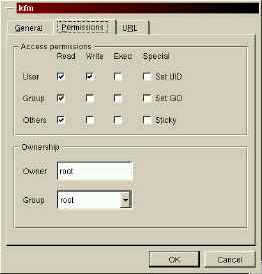
 Getting Started Guide
141
•
The group that the owner is a part of
•
All other users who are logged in to the Linux system.
These three permissions and three groups form a matrix of nine possible permis-
sions. You can change these permissions using either the chmod command (enter
man chmod for details) or by opening the Properties dialog box for any file or
directory in KDE and reviewing the Permissions tab. (See Figure 69).
FIGURE 69. The Permissions tab of the Properties dialog box shows the file
permissions for the selected object.
Only the owner of a file or directory or the root user can change the access rights
to a file or directory. If you don’t have permission to change the file permissions
because you don’t own the object you’re reviewing, the boxes in the Permissions
tab are inactive--you can review but not change them.
You can also change the owner of a file or directory using the Permissions tab or
using the chown command.
Note that these file permissions are not as detailed (granular) as many other sys-
tems such as NetWare or Windows NT, either for the available access rights or
for who can be assigned those rights. File security within Linux is safe, but you
must design your user accounts and group membership to fit the file permissions
structure of the system.
Getting Started Guide
141
•
The group that the owner is a part of
•
All other users who are logged in to the Linux system.
These three permissions and three groups form a matrix of nine possible permis-
sions. You can change these permissions using either the chmod command (enter
man chmod for details) or by opening the Properties dialog box for any file or
directory in KDE and reviewing the Permissions tab. (See Figure 69).
FIGURE 69. The Permissions tab of the Properties dialog box shows the file
permissions for the selected object.
Only the owner of a file or directory or the root user can change the access rights
to a file or directory. If you don’t have permission to change the file permissions
because you don’t own the object you’re reviewing, the boxes in the Permissions
tab are inactive--you can review but not change them.
You can also change the owner of a file or directory using the Permissions tab or
using the chown command.
Note that these file permissions are not as detailed (granular) as many other sys-
tems such as NetWare or Windows NT, either for the available access rights or
for who can be assigned those rights. File security within Linux is safe, but you
must design your user accounts and group membership to fit the file permissions
structure of the system.


